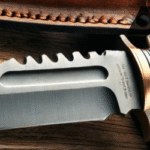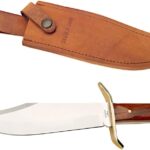If you’re a knife enthusiast, you’ve likely come across both the Bowie Knife and the Kukri. These two knives, while both highly functional and revered for their historical significance, serve different purposes. Understanding the differences in their design, functionality, handling, and durability can help you decide which one suits your needs best.
The Bowie Knife
The Bowie Knife was designed by James Bowie in the early 19th century. It gained fame after Bowie’s legendary knife fight at the Sandbar Fight of 1827, solidifying its place as an iconic blade in American frontier history. Over time, it evolved into a multi-purpose survival tool and remains popular among hunters and collectors today.
The Kukri
The Kukri has its roots in Nepal, where it has been used for centuries by the Gurkha warriors. Its curved blade design makes it effective for both combat and utility work, serving as a weapon in battle and an everyday tool for cutting wood, preparing food, and more. Today, it remains a symbol of strength and honor for the Nepalese army and the British Gurkhas.
Design and Structure
Bowie Knife
- Blade Shape: Features a clip-point blade, which enhances precision cutting and piercing.
- Blade Length: Typically 6 to 12 inches, though variations exist.
- Thickness: Usually 3mm to 5mm, providing a balance between durability and cutting efficiency.
- Handle: Often made from wood, micarta, or rubber, designed for comfort and grip.
Kukri
- Blade Shape: Curved inward, creating a forward-weighted design ideal for chopping.
- Blade Length: Usually between 10 and 15 inches.
- Thickness: Ranges from 4mm to 8mm, making it a robust chopping tool.
- Handle: Traditionally made from wood or horn, often with a notch to enhance grip.
Blade Material and Edge Retention
- Bowie Knife: Often made from stainless steel or high-carbon steel, offering good sharpness and corrosion resistance.
- Kukri: Typically made from high-carbon steel, which holds an edge well but requires regular maintenance to prevent rust.
Cutting Performance
- Chopping: The Kukri’s curved blade and forward-heavy weight make it a superior chopper.
- Slicing: The Bowie Knife excels at precise slicing, making it better for skinning and finer cutting tasks.
- Stabbing: The Bowie Knife, with its sharp clip point, is better suited for piercing and thrusting.
Ease of Use and Handling
- Weight: The Bowie Knife is lighter, making it easier to carry and maneuver.
- Balance: The Kukri’s weight-forward design provides excellent cutting power but requires more control.
- Grip Comfort: The Bowie Knife is often designed for ergonomic handling, while the Kukri’s traditional grip requires skill to use effectively.
Durability and Maintenance
- Bowie Knife: Easier to sharpen, but needs regular honing.
- Kukri: Holds an edge longer but is harder to sharpen due to its curved shape.
Legal Considerations
Laws vary by country and region:
- USA: Bowie Knives are legal in most states, but some restrict blade length.
- UK: Kukris are legal to own but cannot be carried in public without a valid reason.
- Australia: Both knives are subject to state laws and may require permits.
Pros and Cons
Bowie Knife
✅ Lightweight and easy to handle
✅ Excellent for stabbing and slicing
❌ Less effective at chopping
Kukri
✅ Superior chopping and cutting power
✅ Strong and durable blade
❌ Heavier and harder to control
Conclusion
Both knives have unique advantages. The Bowie Knife is better for combat, self-defense, and fine cutting, while the Kukri is superior for chopping, bushcraft, and heavy-duty tasks. Choose based on your needs and preferences.




